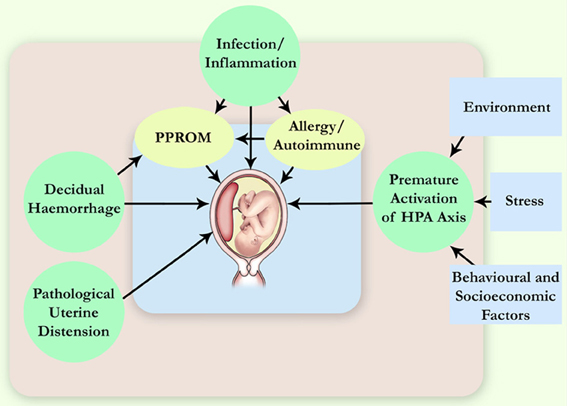Septic abortion refers to a uterine infection that arises during or shortly after an abortion, often resulting in systemic toxicity and sepsis. Among the various causative pathogens, Peptostreptococcus spp., a genus of anaerobic gram-positive cocci, plays a significant role, particularly in polymicrobial settings. These organisms, part of the normal vaginal and gastrointestinal flora, can become pathogenic when introduced into the uterine cavity through non-sterile procedures or compromised mucosal barriers.

Etiology and Pathogenesis of Septic Abortion Caused by Peptostreptococcus
Peptostreptococcus septic abortion typically results from ascending infection following abortion procedures, especially in cases involving unsafe, incomplete, or illegal interventions. The anaerobic conditions of necrotic endometrial tissue and retained products of conception provide a favorable environment for Peptostreptococcus proliferation.
Common Routes of Infection
- Introduction via contaminated instruments
- Incomplete evacuation of uterine contents
- Mucosal injury during dilation and curettage (D&C)
- Secondary infection from adjacent pelvic organs
Risk Factors for Anaerobic Septic Abortion
Several clinical and socioeconomic conditions increase the risk of developing septic abortion due to Peptostreptococcus:
- Unsafe abortion practices or lack of medical supervision
- Delayed presentation following spontaneous miscarriage
- Poor hygiene during medical procedures
- Immunocompromised state (e.g., HIV/AIDS)
- Retained products of conception
- Intrauterine device (IUD) presence during pregnancy
- Low socioeconomic status limiting access to healthcare
Clinical Presentation and Diagnostic Features
Septic abortion with Peptostreptococcus infection typically presents within a few days of an abortion or miscarriage. Due to its anaerobic nature, the clinical course may be subtle initially but escalates rapidly.
Key Symptoms
- High-grade fever with chills
- Foul-smelling vaginal discharge
- Lower abdominal pain and tenderness
- Heavy or prolonged vaginal bleeding
- Cervical motion tenderness
- Signs of systemic sepsis (tachycardia, hypotension)
- Uterine enlargement and bogginess on examination
Laboratory and Microbiological Diagnosis
- CBC: Leukocytosis with a neutrophilic shift
- Blood cultures: May isolate Peptostreptococcus in systemic cases
- Endometrial cultures: Essential for confirming anaerobic infection
- Gram stain: Reveals gram-positive cocci in chains
- CRP and Procalcitonin: Elevated inflammatory markers
- Ultrasound: Retained products or intrauterine gas suggestive of anaerobic infection
Microbial Profile: Polymicrobial Nature of Septic Abortion
While Peptostreptococcus spp. may be a dominant pathogen, septic abortion is almost always polymicrobial. Anaerobic and facultative bacteria co-infect, enhancing virulence and resistance.
Frequently Associated Microorganisms
- Bacteroides fragilis
- Prevotella and Fusobacterium spp.
- Clostridium perfringens
- Escherichia coli
- Group A Streptococcus
- Gardnerella vaginalis
These pathogens form synergistic relationships that degrade tissue, impair host defense, and promote rapid systemic spread.
Management Protocols for Peptostreptococcus Septic Abortion
Timely and aggressive intervention is critical to reduce mortality and preserve fertility. The management approach is multidisciplinary, involving gynecology, infectious disease, and critical care teams.
Empiric Antimicrobial Therapy
Empiric coverage must include broad-spectrum agents active against both aerobic and anaerobic organisms. Recommended regimens include:
- IV Clindamycin + Gentamicin
- Ampicillin + Sulbactam
- Piperacillin-Tazobactam
- Carbapenems (e.g., Ertapenem, Imipenem)
- Metronidazole for anaerobic-specific coverage (in combination)
Antibiotics should be continued for at least 14 days, guided by clinical improvement and culture sensitivity.
Surgical and Supportive Interventions
- Uterine evacuation (D&C or manual vacuum aspiration) to remove infected tissue
- Fluid resuscitation to manage sepsis-induced hypotension
- Vasopressors in cases of septic shock
- ICU admission for hemodynamic monitoring
- Hysterectomy (last resort) in unresponsive, life-threatening infections
Complications of Untreated or Delayed Peptostreptococcus Septic Abortion
Failure to recognize and manage Peptostreptococcus-associated septic abortion can lead to catastrophic outcomes.
Common Complications
- Septic shock
- Disseminated intravascular coagulation (DIC)
- Acute kidney injury (AKI)
- Acute respiratory distress syndrome (ARDS)
- Infertility from uterine scarring or loss
- Peritonitis and pelvic abscesses
- Death due to multi-organ failure
Prevention and Public Health Strategies
Preventing septic abortion, particularly from anaerobic organisms like Peptostreptococcus, requires both clinical and societal interventions.
Preventive Measures
- Ensure access to safe and legal abortion services
- Promote sterile technique and post-abortion care
- Educate patients on early warning signs of infection
- Encourage follow-up evaluations after spontaneous or induced abortion
- Implement antibiotic prophylaxis in high-risk procedures
Peptostreptococcus septic abortion represents a grave gynecologic emergency rooted in both medical and public health dimensions. As anaerobic organisms thrive in the necrotic, oxygen-deprived uterine environment post-abortion, their early recognition and aggressive treatment are essential. A multidisciplinary approach incorporating surgical intervention, appropriate anaerobic antimicrobial therapy, and supportive care dramatically improves patient outcomes and preserves reproductive potential. Preventive strategies, especially in vulnerable populations, are vital to reduce incidence and improve women’s health worldwide.